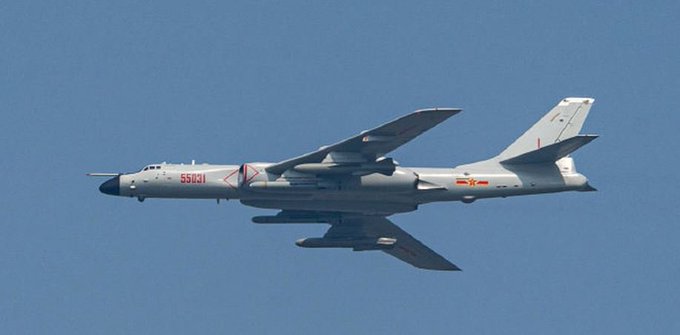China is preparing to show off some incredible weaponry. Here's what it could be

Powerful, domestically-built and in the People's Liberation Army arsenal right now -- China is expected to show off some of the most advanced weaponry the world has ever seen during a special National Day military parade in Beijing on Tuesday, October 1.
About 15,000 personnel, more than 160 aircraft and 580 pieces of weaponry and equipment will be part of the 80-minute procession through the Chinese capital, which will highlight the country's military advances in the 70 years since the founding of the People's Republic of China.
Key among those is drone technology -- of which Beijing boasts some of the world's best -- and advanced missile systems.
Maj. Gen. Tan Min, executive deputy director of the Military Parade Joint Command Office and deputy chief of staff of the Central Theater Command of the People's Liberation Army (PLA), said at a press briefing this week that all weapons to be on display were in service and made in China, highlighting the country's ability to innovate in defense research and development.
Here are some of the key items to look out for Tuesday.
DF-41 missile
Much of the parade hype has focused on this powerful intercontinental-range ballistic missile, thought to be the mainstay of the People's Liberation Army Rocket Forces (PLARF) arsenal for years to come -- and, by some estimations, the most powerful missile on the planet.
Under development since 1997, the DF-41 was rumored to appear in parades in 2015 and 2017, but instead was kept under wraps.
Rumors that it will get a showing this around were sent into overdrive following reports in China's state media that the missile was spotted during parade rehearsals in Beijing earlier this month.
The Missile Defense Project at the Center for Strategic and International Studies says the DF-41 will have a range of up to 9,320 miles (15,000 kilometers), more than any missile on Earth, and will be capable of carrying 10 independently targeted nuclear warheads. From launch in China, it could theoretically hit the continental United States in 30 minutes, the Missile Defense Project says.
Mobile-launched DF-41s can be carried by trucks and trains. Satellite photos taken earlier this year showed DF-41 mobile launchers in the PLARF Jilintal training area in Inner Mongolia, according to the Federation of American Scientists (FAS), which monitors world nuclear arms developments.
Those satellite photos also show what "strongly resembles" a silo, according to Hans Kristensen, director of the Nuclear Information Project at the FAS, who analyzed the images.
Kristensen wrote the possible missile silos appeared to bear more of a resemblance to Russian ICBM versions than existing silos for older, liquid-fueled Chinese ICBMs. The DF-41 is solid-fueled, like the Russian missiles. Solid-fueled missiles are easier to deploy and quicker to launch than liquid versions.
The backbone of the United States nuclear arsenal, the Minuteman III missile, is a solid-fueled, silo-based weapon. However, it carries only one warhead, as its original three-warhead design was limited by nuclear treaties with Russia.
China may be ready to deploy the DF-41 in numbers. At least 18 of them appeared to be at the Inner Mongolia training ground in satellite photos earlier this year.
Though capable of carrying 10 warheads, it is likely only three would be on each missile, with the rest being dummy or decoy warheads, according to the Bulletin of the Atomic Scientists (BAS).
Part of that has to do with warhead availability. China's nuclear warhead inventory is estimated at 290 for use on ballistic missiles and bomber aircraft, the Bulletin said in its 2019 report on Beijing's nuclear forces.
JL-2 submarine-launched ballistic missile (SLBM)
This is the main weapon aboard China's Jin-class fleet of nuclear-powered ballistic missile submarines. Four of the subs are in service, with two more under construction.
Each sub can carry 12 of the single-warhead JL-2 missiles. With an estimated range of 4,473 miles (7,200 kilometers), it is regarded as more of a regional than global weapon.
That range puts targets from India to Alaska in range from coastal Chinese waters, the BAS report says. But for it to threaten the continental US, for instance, the subs would have to get past formidable US anti-submarine choke-points around Japan and deep into the Pacific.
A longer-range SLBM, the JL-3, was reportedly tested in late 2018 and again in June this year, according to Jane's Defence Weekly, but that missile remains in development and it would be a surprise to see it on October 1.
Still, the Chinese SLBM force falls short of the US. The US Navy's Ohio-class ballistic submarine fleet numbers 14, with each of those subs capable of carrying 20 Trident missiles. Each of those missiles can carry up to 10 warheads.
DL-17
This is an example of a hypersonic glide vehicle, or HGV. It is launched via a standard missile rocket -- but after reaching the desired altitude, the booster rocket is jettisoned and the HGV carries the missile payload to target.
HGVs can fly low and fast -- at least five times the speed of sound, or 3,800 mph (6,115 kph), according to the Missile Defense Advocacy Alliance -- with maneuverability to avoid enemy radar detection and air defenses.
China has been testing HGV technology since 2014 and is expected to deploy it in 2020, according to the Missile Defense Project. The DF-17 will be capable of carrying both nuclear and conventional warheads, it added.
A Congressional Research Service report from September 17 notes that the US trails China -- and Russia -- in hypersonic development and is not expected to have an operational weapon before 2022.
The US is also not expected to have a an HGV with nuclear capability, the CRS says. "As a result, US hypersonic weapons will likely require greater accuracy and will be more technically challenging to develop than nuclear-armed Chinese and Russian systems," the report adds.
H-6N bomber
The H-6 has been Beijing's core long-range bomber for years, but images taken during flyover rehearsals for Tuesday's parade show what could be a significant upgrade.
Photos posted on social media sites in China -- which have been popping up on Western sites -- show what appear to be points to mount large missiles.
These could be DF-21 anti-ship ballistic missiles, according to Joseph Trevethick, writing on the War Zone blog.
The ability to carry the DF-21 would give the bomber "an impressive stand-off capability against large enemy warships, especially aircraft carriers," Trevethick said.
Jane's Defense Weekly noted another update on the H-6N over its predecessor, the H-6K -- a nose-mounted probe for aerial refueling. That gives the bomber the ability to fly deeper into the Pacific from the Chinese mainland.
Combined, the two developments mean US aircraft carriers would need to stay further out to sea during conflict and their aircraft, predominantly F/A-18 jets, would have more difficulty reaching targets.
DR-8 drone
This stealthy drone is drawing lots of attention leading up to the parade, much of that due to its sleek shape and supersonic speed.
Thought to be able to fly up to five times the speed of sound, the main mission of the DR-8 could be to get close to foreign aircraft carriers during conflict and send targeting information back to missile launchers, reports say.
Some analysts note that satellite images of what is believed to be the DR-8, as well as tarp-covered objects seen in parade rehearsals, resemble the US military's D-21 supersonic reconnaissance drone, which was introduced in the 1960s.
The D-21 would self-destruct after dropping its high-resolution camera payload into friendly hands. The program was canceled in 1971 after four of the aircraft were lost in missions over ... China.
Sharp Sword drone
China military watchers have been tweeting images of what they speculate is the Sharp Sword, a bat wing-shaped drone designed for use from aircraft carriers.
The drone is thought to have two internal bomb bays and its stealthy design indicates it's built for a new type of drone warfare, says analyst Sam Roggeveen, writing on the Lowy Institute's Interpreter blog.
"What makes Sharp Sword different ... is that it is stealthy, which means it is built not for Afghanistan-type scenarios, where the enemy is equipped with little more than rifles, but for situations where it might have to evade sophisticated air defenses," Roggeven says.
The Sharp Sword was first tested in 2013, and an appearance in the October 1 parade could signal that it's close to deployment.
Other countries, including the US, have been developing drones to use off carriers. The US Navy's MQ-25 Stingray has just started flight tests with an eye to deployment in 2024 as an aerial tanker.
Drone submarine
Images have appeared online of what looks like a large torpedo on the flat bed of a truck.
The state-sanctioned Global Times noted its appearance in rehearsals, adding: "More mysterious was an image of a large autonomous underwater vehicle. Its mission remains unknown."
This could be one of China's first undersea drones. A 2015 report from the Rand Corp. think tank said the Beijing government, relying mainly on military funding, had set up at least 15 research teams at universities and institutes to develop technology for unmanned underwater vehicles (UUVs).
Tanks
Images have surfaced of Type 99 main battle tanks and Type 15 light tanks during parade rehearsals.
A story on the PLA's English website notes the parade would mark the public debut of the Type 15.
It also noted a change in the Type 99s, desert camouflage, which was "delighting enthusiasts who recalled the jungle look of previous parades."
There was no indication as to why the camouflage scheme was changed, but it prompted speculation about whether China sees a new mission for its ground forces.



























.jpeg)
Comments
Post a Comment